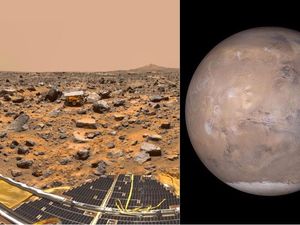This is the chemical we should be looking for if we want to find life on Mars
“Hopefully someone at Nasa reads the paper.”

How do you go about finding clues hinting at life on our neighbouring planet?
Assuming that the next Mars rover won’t be greeted with a martian landing party, geologists have come up with a new way of detecting tiny remnants of bacteria called microfossils.
Scientists at the University of Kansas have suggested Nasa looks for traces of an element called vanadium as evidence of extraterrestrial life.
Craig Marshall, an associate professor of geology and lead author on the paper, says it would be evidence of chlorophyll – the green pigment in plants, which is also present in ancient bacteria.
“Chlorophylls typically have magnesium at the centre – under burial, vanadium replaces the magnesium,” he says.
They’ve found this theory works when detecting early bacteria microfossils here on Earth, similar to what scientists would expect to find if Mars had indeed harboured life.
Marshall compares the microfossils to steak in a slightly gory explanation.
“You can see a steak looks biological – there’s blood dripping from it,” he says.
“Then, you put it in a pressure cooker for very long time, and you end up with charcoal.
“A lot of biological compounds get destroyed and ripped apart from heat and pressure, and you’re left with carbon residue.”
Nasa is sending its next rover to Mars in 2020, and the researchers are keen that the space agency considers their suggestion, which has been published in the journal Astrobiology.
“Hopefully someone at Nasa reads the paper,” said Marshall.







